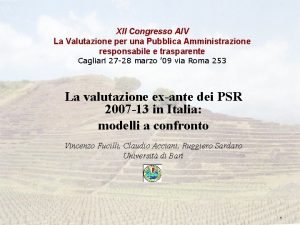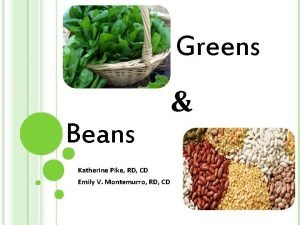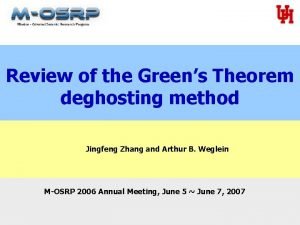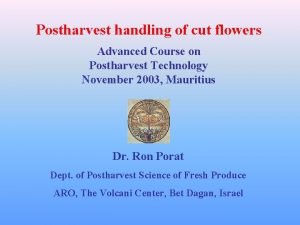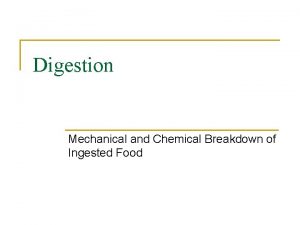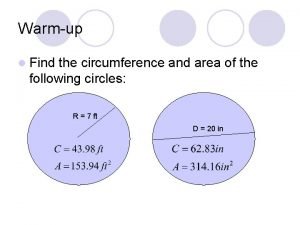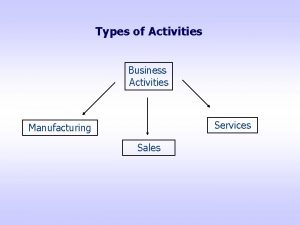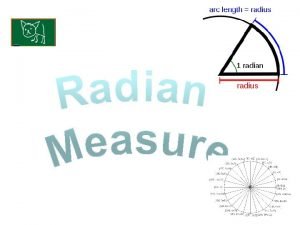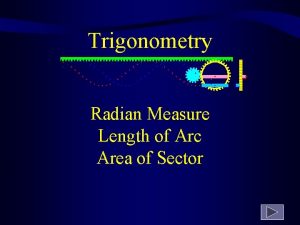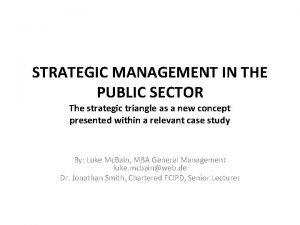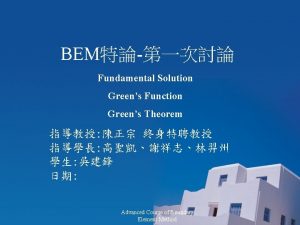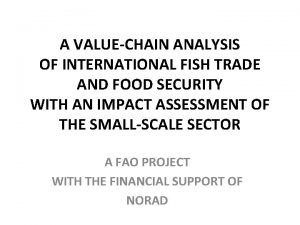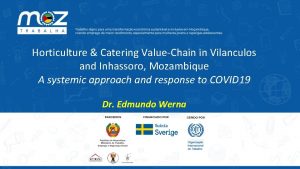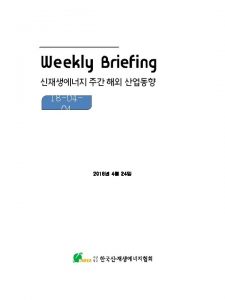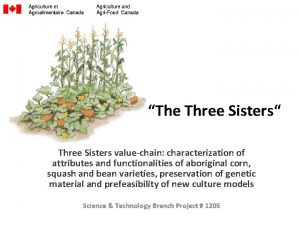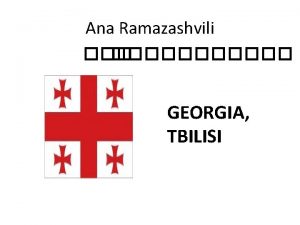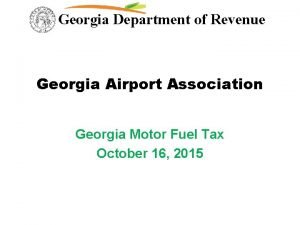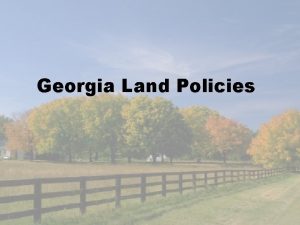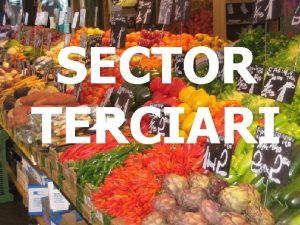Greens Sector in Georgia Greens ValueChain Study Giorgi



































- Slides: 35

Greens Sector in Georgia. Greens Value-Chain Study. Giorgi Andguladze, Giorgi Teliashvili. National Experts on Value-Chains. May 2018 / Presentation of Research Results 1

Content Research Mission and Objectives Methodology Production and Greenhouse Types Standards and Regulation Packaging and Transportation Funding Value Chain Map Export and Prices Recommendations 2

Main Mission of the Study Main types of greens produced in Georgia are: fennel, parsley, coriander, scallion and celery. Research objectives comprise: Production practices in Georgia Export Markets Research of Georgian greens sector: Assessment of Competitiveness Processes encompassing whole life cycle of greens along the value-chain Assessment of Sustainability Problems along the value-chain 3

Methodology Primary and Secondary Research Studies were conducted. Secondary Research: Geostat World Bank Eurostat Research Papers Trademap Comtrade Revenue Service Studies conducted by the EU and other donors. Primary Research: The research was conducted in Tskaltubo municipality of Imereti region. Small, medium and large size producers were targeted. Interviews, discussions, questionnaires with: Greenhouse owners/Cooperatives Smallholders Processors Collectors Exporters/Transporters 4

Value-Chain Research For What? Understanding the Structure of the Industry. Market Specifications. Main actors and leverage points along the chain. Deducing problems and barriers along the value-chain. Assessing investment opportunities. Laying the groundwork for businessplan development. Assessing financial condition of the smallholders involved in the chain. We divide sectorial research into three steps: 1) Country-specific features: regulatory, economic, and trade policy in the country. Factor conditions - mix and cost of available factors, such as wage systems and rates, skill-set of available labour and existence of supplier of inputs/services with various levels of sophistication in the nation. On the demand side - differing segment structures of home demand. 2) General sector-specific features: trade indicators, prices, competitors, valuechain structure, global enabling environment, finance and supporting sectors. 3) Business-specific features: Intricacies and specificities of production and processing practices. Other actors involved in the chain. Financial and economic variables. 5

Value-Chain Research SFVC (Sustainable Food Value Chain): Focusing on Environmental, Social and Economic Sustainability. Supporting Sectors (Indirect Horizontal): Human Resource Availability Governmental Policy R&D and Innovation Grants and Funding Marketing International Organizations Suppliers Donors Processing & Packaging Primary-Production Raw Materials Component Parts Upstream Industries Processing & Packaging Midstream Industries Sales and Distribution Wholesale Retail Downstream Industries 6

Value-Chain Research Indirect Horizontal: Supporting Industries which create the environment in which a value-chain operates. Indirect Horizontal: Direct competitors that operate on the same stage of a value-chain and in the same industry. Vertical: Different industries connected to each other through commercial exchanges and representing each other’s suppliers and clients. The Same Industries 7

Greens Production Metric Tons Production, Imports and Exports Regional Distribution of Production 16 000 14 000 12 000 10 000 8 000 6 000 4 000 2 000 0 2014 Production of Greens Exports of Greens 2015 2016 Imports of Greens Geographic Cluster Analysis in Imereti Greenhouses in Imereti Khoni 1. 4% Baghdati 3. 7% Samtredia 3. 8% Zestaponi 0. 7% Kharagauli 0. 3% Tskaltubo 89. 7% 8

Production There were 3, 100 greenhouses in Imereti in 2016. Out of this 2, 774 greenhouses were in Tskaltubo municipality. Greens Production in Imereti 9

Production in Tskaltubo: Ideal climactic conditions for greens production. Post-harvest life of greens: Under 0 degrees condition it is 2 to 3 weeks. Temperature in Winter is ideal for greens production. 10

Greenhouses Types of Greenhouses: Mainly with plastic cellophanes. Some greenhouses are made of glass. Some are build with wood. On average 500 m 2. Drip irrigation systems deriving water from rivers or underground wells using generators as a source. Drainage and ventilation systems are not present. No heating available. 11

Greenhouses Cultural Practices: Planted in September-October. Seeds imported from Italy, Netherlands, Russia and some are local (Prices vary from 15 GEL to 350 GEL/kg). Laboratory for soil analysis – in Tbilisi, Kutaisi and Gurian region. Vegetation period is from 1. 5 to 2 months – Harvesting about 8 times a season (from November to May) Hired labor – harvests about 30 kg a day and is paid 15 – 20 GEL/day. 12

Standards National Food Agency (NFA) is responsible for compliance with standards. Good Agriculture Practice (GAP) Certificate: for high-value European markets. For exporting to the EU member states: Undergo customs and phytosanitary inspections at the point of entry into the EU (border). Be imported into the EU by an importer registered in the official register of an EU country. Be announced before arrival to the customs office at the point of entry. Documentation Needed for Exports: Certificate of origin of goods: Issued by Georgian chamber of commerce and costs about 100 GEL. Phytosanitary certificate: Issued by National Food Agency of Ministry of Agriculture of Georgia and costs from 50 – 100 GEL. Document from a laboratory: Document confirming laboratorial analysis of greens and a plant-health certificate. Global. Gap: Global. Gap certificate. Technical documentation: An invoice from the buyer and a document specifying details of what is being exported. 13

Packaging and Transportation Packaging: Frequently stored in carton boxes, jute sacs, tied with rubber bands. Capacity: 30 kg. Exporters: Put blocks of ice inside carton boxes. Transportation: Transporting with trucks. Some with refrigerated trucks + blocks of ice. 14

Governmental Policy Funding: Preferential Agro Credit Project - NNLE Agricultural Projects Management Agency. Preferential Agro Credit Project in Imereti 15

0 � � K 10 0 K >1 00 K- � � � 3 00 K K 10 0 91 90 K � 11 >1 K- 1 91 � 0 K 5 71 K- 70 K � � 0 90 � 51 K- 50 K 31 K- 30 K 18 71 K- K 15 70 0 � 50 51 K- 0 � 2 K 8 50 25 K- 15 72 31 25 � 30 K 35 30 40 16 K- 200 16 K- Frequency Distribution (2015) -1 5 K 5 � 2 5 K 19 � 100 -1 6 K 78 6 K 15 5 K � � 181 � K >1 00 10 0 K � Frequency Distribution (2013) 5 K 4 � � K- 91 90 K � � 3 00 K K 4 10 0 � 71 K- 70 K 51 K- 50 K � � � 6 >1 K- 91 K 0 90 � 10 71 K- K 20 70 � 31 K- 30 K -1 5 K K- 16 6 K 5 K 22 51 K- K 40 50 � 45 31 K- K 30 � 0 16 K- 5 K 5 -1 � # of Greenhouses Funded 200 180 160 140 120 100 80 60 40 20 0 6 K 5 K # of Greenhouses Funded Preferential Agro Credit Project Frequency Distribution (2014) 250 232 150 54 0 6 Frequency Distribution (2016) 22 20 11 10 6 2 0 16

Prices Retail price index of greens in 2018 160 140 120 100 80 60 40 20 0 Sept Oct Nov Dec Jan Feb Mar Apr May Jun July Aug Greens Retail Price Index Georgia Greens Retail Price Index Tbilisi Greens Retail Price Index Kutaisi 17

Price Approximate average prices of greens (unprocessed) in 2018 N Georgian Greens 1 Average Price&Cost Units Cost Farm-Gate Price GEL/kg 1. 54 2. 00 3. 4 Wholesale Price Retail Price 4. 45 Margins (Under Normal Conditions) N Georgian Greens 1 Mark-up 2 Margin Units Farm-level Wholesale Retail GEL/kg 0. 5 32. 5% 1. 4 70% 1. 05 30% % 18

Exports of Georgian Fennel (By months and countries) 19

Exports Export of Georgian Fennel by Countries CAGR of Exported Georgian Fennel by Market (2009 - 2016) 90% 80% Ukraine 70% Russia 60% Bulgaria 50% Poland 40% 30% Latvia 20% Lithuania 10% 0% -5% -10% 0% 5% 10% 15% 20% 25% 30% Belarus Average Share in Fennel Exported from Georgia (2009 - 2016) 20

Exports of Georgian Fennel 2 500, 0 3 000, 0 Metric Tons 2 000, 0 1 500, 0 1 000, 0 500, 0 USD (thsd) 2 500, 0 2 000, 0 500, 0 2009 2010 2011 2012 Total Exports USD (thsd) 2013 2014 2015 2016 Total Exports MT 21

Exports of Georgian Fennel 22

Exports Problems with exporting to the EU: It is needed to… Process the greens. Package the greens. Meet minimum volume requirements. Need for Certification: Certificate of origin of goods: Issued by Georgian chamber of commerce and costs about 100 GEL. Phytosanitary certificate: Issued by National Food Agency of Ministry of Agriculture of Georgia and costs from 50 – 100 GEL. Establish connections with importers/distributors. Document from a laboratory: Document confirming laboratorial analysis of greens and a plant-health certificate. Meet standard requirements. Global. Gap: Global. Gap certificate. Technical documentation: An invoice from the buyer and a document specifying details of what is being exported 23

Supply-Chain Greenhouses: Smallholders throughout Imereti. 3, 100 greenhouses in 2016. Cold-Storage: Cold storages funded by donors. Greens stored mostly under minus 2 degrees Celsius before they are exported. Collectors: Collecting greens from smallholders and selling on open-air bazars, markets and supermarkets. Exporters: Collecting greens, transporting to the border and selling to foreign importers. Processors: Purchase greens, process them, package and sell them to supermarkets or to exporters. Retail: Open air-bazaars, stalls, shop counters, supermarkets. 24

Value-Chain Map 25

Assessment of Sustainability Current State of Georgian Greens Sectors can be Evaluated as Significantly UNSUSTAINABLE. Unstable Prices: Fierce competition on an international arena, climactic conditions and variations in yields leads to highly fluctuating prices. Insufficient Revenues: During warm winters revenues plummet for smallholders. Investment: Investment is dependent upon grants, donors and governmental support. Losses: During warm winters large amounts of unsold greens are thrown away. Underutilized Storage: Cold storage facilities are largely underutilized. Seasonality: No exports of Georgian greens in Summer. Exports: Dependency on post-soviet markets. Added Value: The current value-chain mostly supplies to low-value endmarkets, such as open air-bazars, shop counters or post-soviet markets, so value addition in Georgia is limited. Note: Not enough margin to meet the standards and supply high value markets. 26

Exports During Summer Average Fennel Imports During Summer Months (2015 – 2016) N Importing Country 2015 -2016 (Tons) 6, 952 Possible Share of Summer Imports that Georgia Could Take N Possible Share of Total Imports Tons 1 1. 0% 104 2 1. 3% 135 1 France 2 Germany 3 Britain 4 Netherlands 188 3 1. 5% 156 5 Romania 43 4 2. 0% 208 6 Poland 164 5 2. 3% 239 7 Lithuania 97 8 Latvia 45 6 2. 5% 260 9 Total 10, 401 7 3. 0% 312 981 1, 933 27

Exporting in Summer Additional Land Needed (ha) Additional Land Needed for the Production of Fennel to be Exported in Summer E. g. to produce 300 tons of greens for exporting in Summer 8 ha of additional land will be necessary (considering yield will reach 40 ton/ha) 45 40 35 30 In 2016 748 ha of land was used for greens production in Imereti. 25 20 15 10 5 0 8 11 15 18 20 25 30 35 40 Yield (tons/ha) 104 135 156 208 239 260 312 Possible Production (tons) 28

Export Markets Which are the most attractive EU markets for Georgian greens producers? Evaluation of Export Markets Why? Lithuania Latvia Romania Bulgaria Poland Germany 29

Export Markets Average Yield Rates Compared to EU Member States Lithuania Latvia Bulgaria Poland Germany Romania 30

Consolidation Center Consolidating Smallholders: Training greenhouse owners on Global. GAP practices and standards. Supply: Bringing smallholders under one umbrella and homogenizing + stabilizing produce. Post-harvest techniques: Training smallholders on post-harvest techniques especially during hot summer months. Purchasing Greens: Greens should be purchased from smallholders for at least 2. 00 �/kg. Necessary post-harvest techniques: Harvesting and fieldwork should be directed to protecting the harvest from the sun and overheating. Pre-cooling of greens after harvest (Vacuum Cooling is recommended). Processing and packaging with ventilated plastic and carton boxes. Refrigerated storage at +1 Degree Celsius. Refrigerated transportation at +1 Degree Celsius. Loading and unloading areas that provide cool conditions for greens. 31

Consolidation Centre Scale of a Consolidation Center: In case of right cultural practices greenhouse owners can achieve an yield rate of 40 tons/ha. It is recommended to operate the consolidation center at a minimum turnover of 70 -80 tons a year to breakeven. Minimum export price of 15 GEL/kg. Operating profits above overhead/administrative costs 32

Consolidation Centre Revenues above total costs at varying production scales and prices Possible Unit Price Variations (�/ton) 33

Global. GAP Certification Global. GAP Certificate: Comprises guidelines of practical standards. Starting from before the plant is in the ground (seed and nursery control points) Harvest Operations Non-processed end product (Produce Handling control points) A system of monitoring will need to be established to monitor the practices of smallholders involved in the chain. Certifying Bodies (CBs): Issue Global. GAP Certificates. A document will have to be developed outlining Global. GAP standards and practical guidelines – Involving all smallholders and employees of the center. As of now, Herbia is the only processor in Georgia that holds Global. GAP certificate. 34

Air Transportation Kutaisi Airport: Currently does not handle cargo transportation and does not have cargo terminals. Is close to Tskaltubo. We estimate that transportation cost could go up on average by more than 1. 2 GEL to 1. 65 GEL per kilogram shipped by air – compared to road and marine transportation. Air transportation will extend postdistribution life of Georgian greens to 2 - 3 weeks if proper cold-chain is established. Although, transportation cost will increase significantly. 35
 De giorgi matematico
De giorgi matematico Marco de giorgi funzione pubblica
Marco de giorgi funzione pubblica Giorgi kacharava
Giorgi kacharava Green's stokes and divergence theorem
Green's stokes and divergence theorem Dry greens
Dry greens Triangle greens and grass
Triangle greens and grass Vitamin a foods examples
Vitamin a foods examples Green theorem
Green theorem Post harvest handling of cut flowers and greens
Post harvest handling of cut flowers and greens Carbohydrate digestion
Carbohydrate digestion Doc greens menu
Doc greens menu Emerald ash borer nj
Emerald ash borer nj Forever fields of greens benefits
Forever fields of greens benefits Case study georgia tech
Case study georgia tech Gridworld case study answers
Gridworld case study answers What is case series
What is case series Retrospective cohort study vs prospective cohort study
Retrospective cohort study vs prospective cohort study Work study definition
Work study definition Marty lobdel
Marty lobdel Study to study
Study to study Time study meaning
Time study meaning Differentiate between time study and motion study
Differentiate between time study and motion study Tertiary world geography definition
Tertiary world geography definition Rust belt
Rust belt Calculate sector area
Calculate sector area Holy sector model
Holy sector model Higher business management
Higher business management Types of business activities
Types of business activities Sector perimeter
Sector perimeter Minor arc length
Minor arc length Area of a sector radians
Area of a sector radians Unorganised sector meaning
Unorganised sector meaning Assumption of two sector model
Assumption of two sector model Factors of production
Factors of production Multiple nuclei model ap human geography example
Multiple nuclei model ap human geography example Strategic management concepts in the public sector
Strategic management concepts in the public sector

